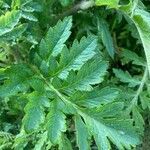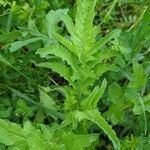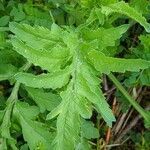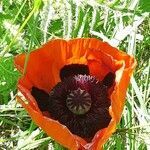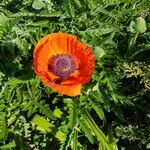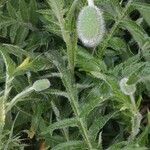Herbs, perennial, setose throughout, ivory lactiferous. Roots whitish, fusiform, fleshy, with numerous fibrous roots. Stems erect to ascending, tufted, 60-90 cm tall (cultivated plants over 100 cm), erect, terete, almost compressed-or appressed setose, leafy in lower 2/3. Basal leaves green on both surfaces, ovate to lanceolate, 20-30 cm including petiole (longer in cultivated plants), sparsely serrate or incised, teeth bristle-tipped, both surfaces setose, bipinnatipartite; lobules lanceolate or oblong. Cauline leaves many, alternate, similar to basal leaves, but smaller; lower leaves long petiolate, uppermost sessile. Flowers solitary, terminal, bowl-shaped, large, 10-16 cm in diam. Pedicel densely setose. Flower buds erect, ovoid or broadly ovoid, 2-3 cm, spreading setose. Sepals 2, sometimes 3, outside green, inside whitish. Petals 4-6, red or carmine, with or without a basal dark blotch or flecking, broadly obovate or flabellate, (3-)5-8 cm, basally shortly clawed, abaxially with thick veins. Stamens numerous; filaments dark, filiform, below ampliate; anthers indigo-violet, oblong. Stigma 10-16-rayed, actinomorphic, indigo, uniting into compressed disk, margin sparsely thickly serrate. Capsule spheroidal, 2-3.5 cm in diam., glabrous, with a flat 10-16-rayed stigmatic disk. Seeds brown, orbicular-reniform, broadly striate, with small foveolae. Fl. Jun-Jul. 2n = 28.
More
Plants to 10 dm, hispid. Stems simple or rarely branching. Leaves to 35 cm. Inflorescences: peduncle moderately to densely appressed pale hispid; bracts sometimes 1-4 just beneath flower. Flowers: petals light orange to orange-red, usually with pale basal spot, sometimes dark-spotted or unspotted, to 6 cm; anthers violet; stigmas (8-)11-15, disc flat or shallowly convex. Capsules sessile, subglobose, obscurely ribbed, to 2.5 cm, glaucous.
A poppy which keeps growing from year to year. It grows 60-100 cm high and spreads 30-50 cm wide. It forms a clump. The leaves are blue-green and bristly. They have leaflets along the stalk and the leaves are 25 cm long. The flower stems have leaves on the lower half. The flowers occur singly and are 10 cm across. They can be red, orange or pink and often have darker blotches.
